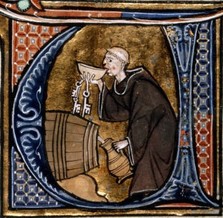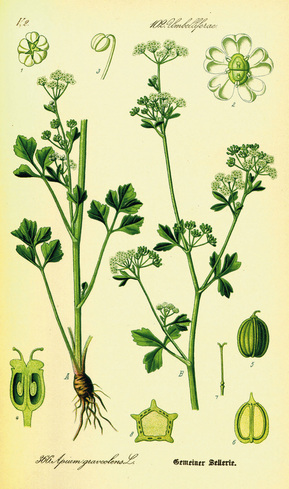|
This is probably Aldobrandino de Siene's claim to fame, as it is a frequently reproduced image from a 13th century illuminated text. Le Régime du corpsThe Le Régime du corps (Regular Care of the Body) is Aldobrandino’s 13th-century text covering all aspects of health (preserving health, care for different parts of the body, diet, and physiognomy [judging someone’s character from facial appearances]). In it, he describes some ailments caused by drinking beer. Whether it is beer brewed from oats, wheat or barley (or a mixture thereof), it harms the head and stomach, gives you bad breath, hurts your teeth, and fills the head with bad fumes (that one may be true). Given that Aldobrandino was Italian (and wrote in French) I would venture to guess there was a strong wine bias here towards beer. In any case, if one must drink a beer, that which is brewed from rye (or rye bread) with mint and wild celery is best. This sounds very interesting. Ingredients
As with most research, I am left with more questions than answers. Would love to know whether rye beers such as this were common, and how it fits into the gruit scene of Medieval Europe. I’m a fan of rye beers, and honestly, I could see a mint / celery combination being pretty tasty, albeit a hard one to nail down. I really need to get my home brewery up and running, so I can give this a try. ResourcesAdamson, Melitta Weiss. Food in medieval times. Greenwood Publishing Group, 2004.
Scully, D. Eleanor, and Terence Scully. Early French cookery: sources, history, original recipes and modern adaptations. University of Michigan Press, 2002.
0 Comments
Alcohol History Links June 18 - 24thSlow news week, but that’s kind of expected. Su PutaLars continues his post series about his travels through Lithuania. The place is called Su Puta (heh), and was actually a farmhouse before it was a brewery. What I find interesting is the continued use of birch (or Juniper in Scandinavia’s case) infusions to clean vessels. Would be particularly useful for wood vessels, I imagine. Just more and more reasons as to why I should buy a plane ticket to Lithuania. I particularly like the sentiment though, ‘...it’s clear that these people don’t just work as brewers. They are brewers.' Let's Brew 1891 Barclay Perkins KKNice simple beer recipe from 1891. Ancient Wine & Beer Experiment - Research DocumentaryA kickstarter campaign to document a Master’s thesis about the archaeology of beer and wine. The video is a bit rough, and I am still not quite sure how this would all work. But I am all for more research into the use of intoxicants in archaeology. William Penn’s Wife’s 342-Year-Old Cider Recipe Sees New LightA recreation of cider, for once! But then again, not sure what really makes this ‘historic’ besides the addition of spices. Which, people are still doing anyway.
Alcohol history links june 11 - 17thI Tried a Medieval Diet, And I Didn't Even Get That DrunkA week and a half diet of medieval foods? Hell yes. Seems pretty healthy, too. It’s based off of the Regimen Sanitatus Salernum, a collection of advice from English royal doctors in the form of a poem, no less. I’ll have to give it a go one of these days, but maybe substitute the diluted red wine with table beer instead. lauter and spargeMerryn Dineley recently provided a very thorough explanation of the lautering and sparging stages of the brewing process, with historical information to boot! London’s earliest named brewer – or London’s earliest named maltster?Martyn Cornell once again provides some fascinating material. He goes over the recent Museum of London Archaeology findings where a wooden tablet addresses a brewer named Domitius Tertius Bracearius. According to Cornell, though, the translation is more likely to be maltster, rather than brewer, and goes on to provide some convincing evidence. But as he points out later on, even if he was a maltster, he must have been selling his wares to brewers in London. Peruvian beers win medals at South Beer Cup Cervecería Barbarian, a brewery from Peru, won three silver medals at the South Beer Cup, South America’s leading craft beer awards. One of the winning beers, though, was a Chicha - an ancient Peruvian style of beer made from corn. Always good news when ancient beer styles win. World's oldest beer brought back to life, scientists claimA captivating title, but a bit misleading. I have my suspicions on the accuracy of this, and as others have pointed out online, there were probably more bugs in there besides S. cerevisiae and brettanomyces. Still a fun read though. Thanks to Merryn Dineley for bringing it to my attention.
Alcohol history links June 3 - 10
Everything Old is Brewed Again Nice to see that historically inspired beers are starting to get traction. If there’s one thing I learned during my MSc, its that beer can be much more than barley, hops, and S. cerevisiae. Hopefully in the coming years, such beers become more prevalent. [Gastropod] Prehistoric wine-making at Dikili Tash (Northern Greece): Integrating residue analysis and archaeobotany Now this one isn’t as fresh off the press (being public since May 31st), but I only found out about it the other day. I’ll have to do a proper sit down and do a thorough read-through, as it’s very interesting. Seems like Garnier and Valamoti discovered some Neolithic winemaking from around 4300 BCE in Greece. Pretty big claim as it would provide the earliest evidence for winemaking in the Eastern Mediterranean and Europe. [Science Direct] Piniavos Lars continues his travels through Lithuania. This time he stops off at the Piniavos brewery, an old - granted it uses modern equipment - farmhouse brewery. Some really interesting brewing methods here, like using raspberry stems and a two wort blending technique. [Larsblog] Dark Mild Some musings on the Dark Mild, which interestingly wasnt used much before WWII. Reading this makes me wish I still lived in England. A mild would really hit the spot right about now. [Barklay Perkins] Brewing in ancient Egypt is a fascinating topic, but a tedious one to study. Given the earliest evidence for Egyptian brewing dates around 3500 BC and continues through the Ptolemaic period some 3,000 years later, that amount of time must have led to changes in brewing techniques, ingredients, and better technology. But there is not a whole lot out there. There is no evidence to suggest the Egyptians stopped brewing, but it probably tailed off in popularity once the Greeks stepped in. The Greeks did impose a beer tax in Egypt for the first time, after all.
Anyway, the Egyptian word for beer was hqt (heqet), and the names Egyptians gave to their types of hqt were pretty cool. Some early sources from the Pyramid Texts - religious texts from Old Kingdom era Egypt - call out a few beers. These are: dark beer, iron beer, hes-beer (garnished), and the beer of Nubia. A few beers that are particularly interesting are the beer of truth, beer which does not sour, and beer of eternity. The beer of truth, also called the beer of the goddess Maat, was designated for the 12 gods who guarded the shrine of Osiris. These latter two beers are assumed to have an extended shelf life, given their names. How old school Egyptian brewers were able to do so, I have no idea. It is some feat to get a beer to preserve given that the Egyptians (seemingly) had no means to protect their beer from microbial attack. Maybe they had plants with the same preservative powers as hops, or maybe they upped alcohol content by adding dates...but who knows. |
Jordan RexBeer archaeologist Archives
November 2017
Categories
All
|




 RSS Feed
RSS Feed
